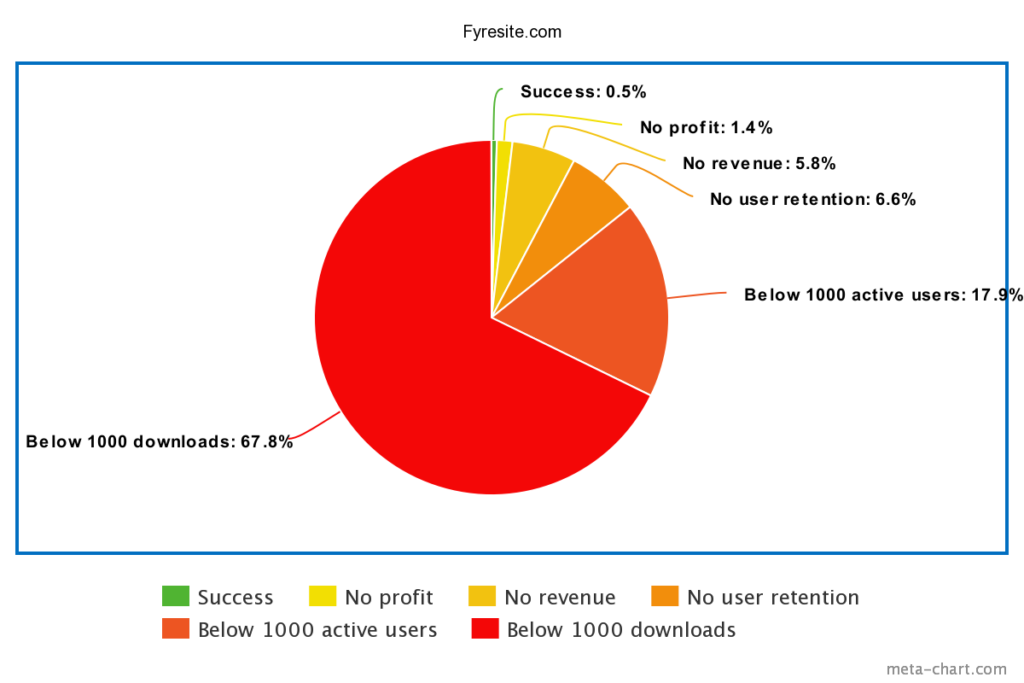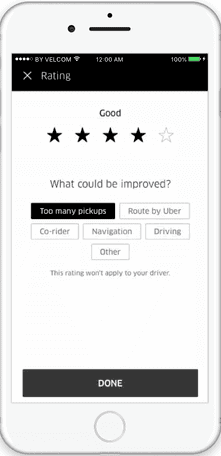Stay Ahead of the Competition: Best Mobile User Acquisition Tips for 2022
The mobile app market is in a frenzy and oversaturated. It is becoming harder to retain the attention of users these days, and it seems like everyone’s ready to hit the “uninstall” button at any slight irritation. Marketers seek to develop the best user acquisition strategy to be among that 0.5% of apps that succeed. Yes, the success rate of mobile apps is this low; according to a recent study, 99.5 % of mobile apps fail to become financially successful.

Image source: https://www.fyresite.com/how-many-apps-fail/
Interestingly, still more apps are launched every day to add to the existing number. Recent findings show that, in the first quarter of 2021, over 5.7 million different mobile apps were uploaded to all top mobile app stores combined – and more are added daily.
In another report, in 2021, approximately 230 billion mobile apps were deployed across various mobile ecosystems. This demonstrates that the mobile app market is, indeed, expanding at an exponential rate.
With these reports, there is no doubt that mobile app marketers face fierce competition due to impetuous market growth.
Today, it is no longer enough to develop or launch a mobile app. It is imperative, early on, to incorporate effective user attraction strategies into a marketing plan.
To succeed in this space, as a mobile app marketer, you must be meticulous with your user acquisition strategy. You’d have to utilize all possible approaches to attract a good percentage of users to your app(s).
In this article, I’ll explain how user acquisition works in mobile and will provide you with strategies for promoting your apps.
Factors that Influence User Acquisition in Mobile
The term “mobile user acquisition” refers to the number of new mobile users who can be converted to achieve an app’s goal. This goal could be to install, purchase items through the app, provide personal information, sign up for news, etc.
There are several tactics that you can use to achieve these goals; however, in order to be effective, the tactics that you choose must be tailored for the mobile environment. If resources are available, a more diverse acquisition approach can also be implemented to achieve really spectacular outcomes.
According to reports, 80% of users abandon an app after about three months. Over time, this has become a common occurrence and it is now considered normal. As a result, if you want to retain new users and keep them engaged, you must consider the factors that drive user acquisition on mobile, as outlined below.
Ability to promote and sustain a satisfying user experience
Your app must be fully optimized; by this, I mean the ability of your app to be lightweight (for quick download). The user experience must be impeccable as well – the app should load quickly, use little battery power and not consume too much internet bandwidth.
Also, paying attention to your target audience’s complaints and recommendations in the app store and fixing the technical glitches on your app can go a long way in enhancing your app’s user experience and keeping your app installed on users’ devices. An example is Uber and UberPool – both leverage users’ ratings to optimize their services.

Image source: https://static.getsocial.im/uploads/uber-1.png
Ability to offer value and address users’ concerns
What is the goal behind app development? To increase the number of app installations and generate income; however, you will only be able to make money from your app if you can deliver genuine value to your customers. Therefore, while planning out the app, you should think this and clearly state how users will benefit from your app. How does it address a particular need? When a need is met, users will keep your app installed for a long time.
Capacity to compete ethically
Your app must have a unique value proposition that gives it a competitive edge over other apps. Where this is lacking, you risk losing your app users to the competition. Is your app more efficient than others? Is it possible for your app to deliver a service that no other one can match? Can users get a solution quicker with your app compared to the alternative ones? Would users need a discount if they use your app? You should have answers to these questions before the app is developed.
When developing a customer attraction strategy for mobile apps, list the essential features you offer to your customers and emphasize one of them. If the benefit isn’t immediately apparent, the app won’t be able to compete and earn money. Advertising can be used to develop a value proposition that is appealing to customers. A 10% discount on every app order is an obvious and understandable benefit to a user. Benefits should be obvious to the users – only in this way will you be able to increase user retention.
Organic mobile marketing user capture
Organic mobile marketing user acquisition is about using organic traffic to acquire customers – in this context, mobile app users. This technique has been found to work best for business to consumer (B2C) businesses that have sound knowledge of their target audience. Popular organic mobile marketing user acquisition sources and/or channels include websites, blogs and social media sites. You can adapt the strategies mentioned below to get the most out of your organic mobile acquisition efforts.
Properly optimize your mobile website
For the best results, it is important to enhance your landing pages and mobile website for specific SEO keywords. To maximize your ad spend, a landing page should be built at the start of a mobile ad campaign to accept visitors and ensure that details like prices, coupons and dates on the creative match those on the landing/website.
However, all efforts should not be spent on SEO, as optimizing your blog for search, volume and placement of keywords should not be at the expense of the quality and usefulness of content. To get started, content must be accurately displayed on mobile devices, followed by creating a content marketing plan for the blog.
Select the right ad formats that complement the content
Publishers whose mobile websites have high traffic don’t want to miss out on the possibility of earning more revenue from their content. This is because for each ad view amassed, they receive a share of the advertiser’s budget. These programmatic advertising systems make the process of ad placement easy by linking global mobile publishers with advertisers; this way, publishers automatically find the best option for mobile inventory monetization and advertisers instantly reach suitable publishers who support the ad formats that they serve.
It’s worth noting that mobile ads may appear within apps or on mobile web browsers. While mobile web campaigns may share similar ad formats with desktop web campaigns, the approach in choosing the best ad format may be different and depend on the objectives and screen resolutions.
When developing in-app or mobile web creative, it is essential to adhere to proven formats, applying the appropriate heights, weights and resolutions, as well as including CTA and links in the banners to direct the audience to the landings and boost user acquisition.
Factors that Influence User Acquisition in Mobile
Demind Side Platform (DSP) can help you to advertise apps across various mobile channels, as it is a viable tool for mobile app user acquisition.
One option is to allow the system to use RTB protocol that will automatically find desired audiences, bid on impressions and then serve the ads on mobile inventory. Another option is using programmatic direct deals, where you deal directly with the publishers without participating in the auctions. When done right, either method can give you the best return on your ad spend.
Employ targeting
Every audience segment that you try to reach may have a specific set of parameters that you can target on a DSP. DSP, with its number of targeting criteria, can help you to individually address every audience segment. Among the targeting options to consider are the browser, the geographic location, the connection type, the device brand GPS, the IAB categories, the language, the gender and the age.
Explore media ad formats
Using a mix of image/banner and video ad formats can greatly enhance your mobile app’s user acquisition efforts. Banner ads are arguably cheap, easy to use and supported by almost all DSPs, which makes them the preferred option for app monetization – especially for free apps. You may also use video ads that last up to 30 seconds to reach outstanding completion rates. Other ad formats that you might want to consider include native, rewarded video ads and playable interactive formats.
Make use of retargeting
You can do mobile retargeting via DSP, thereby re-introducing your offer to people who once visited your website but didn’t convert. Additionally, retargeting helps you to greatly reduce the chances of ad fraud, because you get to reach out again to users who visited your website or app so that you can be sure all impressions are viewable.
Influencer marketing as a mobile user acquisition approach
For the past few decades, social media influencers have paved the way for effective mobile marketing. These bloggers, celebrities and blog owners can use their popularity to promote various products and services.
This advertising strategy is not restricted to just a person but can involve an entire organization, stimulating more audience interest. The advantage of using influencers for marketing is that they can connect with people exceptionally well.
Below are some tips to get the most returns from your mobile user attraction strategy with influencer marketing.
Define the target audience. Targeting a particular audience for advertisements is of prime importance to the effectiveness of the mobile app acquisition strategy. If you involve an influencer, it should be one with an audience you can advertise to. For example, a popular and professional athlete would make a good influencer for a sports product, like a shoe.
Choose the platform. When choosing an influencer, you should also consider the platform(s) where your product will be advertised. YouTube, Twitter and Instagram are great choices, but their audiences differ. Knowing the platform where your target audience congregates can help you determine the effectiveness of your promotion.
Knowing how to measure effectiveness. Before and after engaging an influencer to promote your ads, you have to consider different parameters that you can use to determine whether or not the promotion is/was successful. Comparing the number of people who saw your ads to the number of installs or sales is a good way to determine the effectiveness of influencer marketing.
Finding new users through email marketing
Email marketing is of great relevance for any successful mobile app user acquisition. The effectiveness of email marketing, by far, outweighs that of social media advertising because of the high rate that people click email links, especially on mobile devices. Because of this, you should format your email newsletters to appear perfectly on all mobile devices.
Be concise. No matter how interesting your offer is, nobody likes to read an email newsletter that is too long. So, while utilizing email for your marketing, keep the message short and garnished with perfectly optimized pictures. This method has helped Uber increase its app user acquisition by 443% in just three years using email marketing.
Personalization. Different audiences find different things appealing. Since apps are usually advertised worldwide, you must ensure that you take this into account when sending out your email newsletters. Divide your email newsletters into different segments based on user interests, preferences and geolocations. Create several versions of email newsletters for each segment. This will help you send only targeted emails to specific users at the right time.
Include deep links. Some users need a prompt or a link directing them to the correct app. This is where including deep links in your email newsletter will be helpful. Deep links in your email newsletter will increase downloads and allow you to track the effectiveness of your email retargeting campaigns.
Conclusion
Understanding mobile user acquisition will aid you in developing a good marketing plan. I am sure that if you implement the recommendations from this guide, you will quickly attract new users to your mobile app and grow it to be very profitable. In addition, partnering with a demand-side platform would further enable you to optimize your user acquisition strategy. DSPs leverage programmatic advertising technology that allows you to channel your ads across various mobile applications and with optimal reach.

